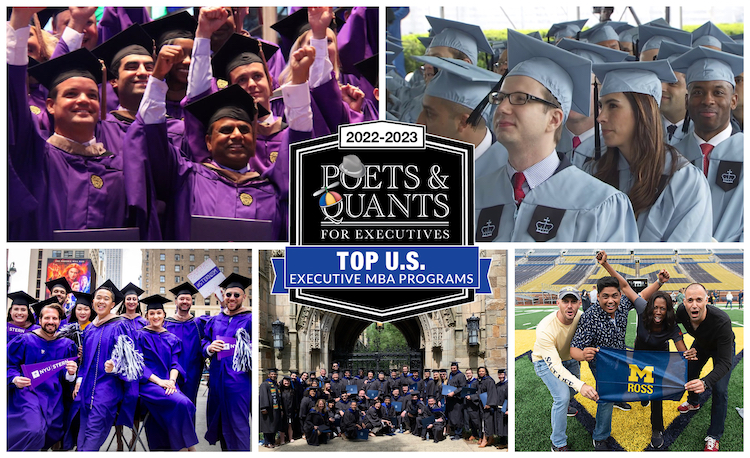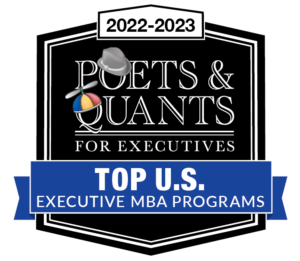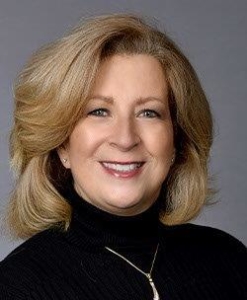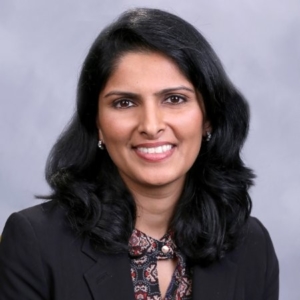
Kellogg School of Management at Northwestern University has returned to a familiar place in Poets&Quants’ 2022 composite ranking of the best EMBA programs in the United States: The very top.
Kellogg shot up to No. 1 after finishing 13th in P&Q‘s composite ranking of 2021 — a year in which several top schools fell sharply after choosing not to participate in one or more of the premier rankings.
In P&Q’s 2022 list, Columbia Business School slipped one spot to No. 2. Rounding out the top five were the University of Michigan’s Ross School of Business (No. 3), New York University’s Stern School of Business (No. 4), and Yale School of Management (No. 5).
EMBA RANKINGS: A DIFFERENT BREED
 For many would-be applicants to Executive MBA programs, rankings are a useful guide, though because most EMBA choices are made by geography, rankings place a smaller role than they might for those researching full-time or online MBAs. Generally, executives want to attend the best program in their city or region to eliminate the need to travel on a regular basis for courses. If a prospective student lives in Atlanta, for example, the best option will be Emory University’s Goizueta School of Business, which ranks among the top ten (in eighth place). If an executive is in the Dallas-Fort Worth area, the EMBA program at Texas Christian University (31st) should be at the top of the list.
For many would-be applicants to Executive MBA programs, rankings are a useful guide, though because most EMBA choices are made by geography, rankings place a smaller role than they might for those researching full-time or online MBAs. Generally, executives want to attend the best program in their city or region to eliminate the need to travel on a regular basis for courses. If a prospective student lives in Atlanta, for example, the best option will be Emory University’s Goizueta School of Business, which ranks among the top ten (in eighth place). If an executive is in the Dallas-Fort Worth area, the EMBA program at Texas Christian University (31st) should be at the top of the list.
So for most schools, it is more important for a program to be ranked among the best, rather than what the program’s actual rank might be. In fact, the networking value of a regional program can provide as much bang for the buck as a school with a national or global reputation. The upshot: Think of a ranking as something of a seal of approval, third-party validation of a program’s quality and strength.
Professionals who opt for executive programs tend to be older and more experienced than students in full-time programs. They are also able to immediately apply what they learn in the classroom on the job. And many of them have specific needs to fulfill. Maria Villaquiran, 31, a senior manager at EY, wanted a program that guaranteed a dynamic academic experience and an entrepreneurial mindset. “I wanted to develop strategic business management and growth skills that can anticipate change and opportunities in the market,” says Villaquiran, who graduated from Columbia’s EMBA program this year. “Moreover, as a consultant, I knew I had to figure out a way to develop an entrepreneurial mindset to create and capture market opportunities with speed and accuracy. CBS offered everything I was looking for when compared to the other executive MBAs in the Northeastern U.S.”
Indeed, the reliance of teamwork at Kellogg has long. been a primary difference. “I think it’s the collaboration” that sets Kellogg apart, says Bernadette Birt, assistant dean of Kellogg’s EMBA program. “It’s the partnership between the faculty, the administration, and the students. If we bring you in the door, we know you have a lot of heavy lifting and work to do, but we want to make sure that you’ve got a path forward to be successful.
“I think it’s also giving our students some runway to make decisions outside of the classroom about what their experience is going to be,” Birt tells P&Q.
P&Q’s COMPOSITE OF 3 EMBA RANKINGS
P&Q’s composite is based on schools’ performance of their U.S.-based programs in the three major EMBA rankings: U.S. News & World Report, the Financial Times, and The Economist. P&Q gives equal credit to all three rankings, so schools are penalized by the methodology when their programs fail to finish in all three. (The Economist, which announced last month that it was killing its MBA ranking because of withering criticism, did not release an EMBA ranking in 2021, so we used its 2020 ranking for this composite.) Ranks shown for both the Financial Times and The Economist are their U.S. ranks, not the programs' global rankings. The top school was awarded 100 points, while second place awarded a school 99 points. The total points awarded were then divided by three and put into an index to create the ranking.
Each of these rankings are based on vastly different methodologies, making oranges to oranges comparisons more difficult across them. U.S. News bases its ranking of the Top 25 U.S. programs entirely on a survey sent to deans and senior faculty of business schools. The Financial Times surveys both schools and alumni for its ranking, collecting data on 16 different metrics. About 4,770 alumni completed the FT ranking, providing data on salary increases after the program, career progress, and aims achieved, which all together account for 55% of the school’s ranking weight. The Economist culls 24 different metrics from surveys to schools and alumni, placing a weight of 27.5% on pay alone. Roughly 8,500 alums completed The Economist surveys in 2020.
Besides our updated composite list, our ranking table shows prospective students how schools fared in each of the three rankings. (Click pages 2 and 3 for the full list).

Inside an EMBA classroom at Kellogg School of Management. Courtesy photo
KELLOGG’S RETURN TO THE TOP
In our 2021 composite ranking, several brand-name schools fell out of the top 10 after declining to participate in either The Financial Times or The Economist rankings due to the pandemic. Chicago Booth, for example, sank to 24th after withdrawing from both while the Wharton School fell to 14th after falling off the latest Economist ranking. Those drops were less a reflection of the quality of the programs and more a consequence of their reluctance to put their programs to the test of a third-party evaluation.
Kellogg, meanwhile, dropped from third place in 2019 to 13th place in 2021 after declining to participate in The Financial Times ranking. However, Kellogg returned this year, earning No. 3 for U.S. schools in FT and also ranking No. 1 in U.S. News’ EMBA list and No. 2 on The Economist’s, grabbing the highest composite score of our ranking. (In August, it also ranked No. 1 in Fortune magazine’s inaugural ranking of EMBA options, but that did not factor into our ranking because Fortune's lacks the influence and credibility of the other rankings.)
Kellogg enrolls two EMBA cohorts (one in January and one in September) for each of its two programs – in Evanston, Ill., and Miami. The Evanston cohorts are generally between 70 and 75 students, while Miami’s are between 50 to 65. With a price tag of $226,638, the total cost for the two-year program isn't inexpensive. But the most highly ranked EMBA programs are premium products for schools that typically treat students as if they were staying at a five-star hotel. They are taught by the best faculty, wined and dined and put in lush accommodations for their overnight stays.
And for many, a school's reputation is critical. "I wanted to go to a top five business school with an expansive global footprint, a lot of diversity, a collaborative culture, and a structure I could manage with my job and family," explains Megan Wenrich, global director of philanthropy effectiveness at The Nature Conservancy and a 2022 graduate of Kellogg's EMBA program in Miami. "Kellogg was the only school that fit the bill. The Miami campus is rich with diversity in all dimensions – geography, industry, ethnicity, functional role, education – we sort of joke that the only thing we all have in common is ambition. The once-a-month format seemed doable for me and I was sold on the school’s 'low ego, high impact' ethos, expansive network of global campuses, and its deep commitment to collaboration & the study group model."

Bernadette Birt, Kellogg
Throughout the pandemic, the timing of applications at Kellogg programs has ebbed and flowed, with some applications coming in later than usual as candidates adjusted to circumstances. “We’re seeing, probably, a higher number of people in healthcare, biotech and pharma coming back in, and we still see strong interest from technology sectors which touch so many different areas,” Birt tells P&Q.
Kellogg has the longest-running healthcare business program in the country, and its new Healthcare at Kellogg (HCAK) Deep Dive Program combines students from across its MBA programs, including EMBAs, and connects them with the school’s 4,000 alumni working in the industry. It enrolled about 80 students in its first cohort earlier this year.
“Healthcare is an area that is growing and changing so much; There’s a lot of interest in population health, cost of health care” and so forth, Birt says. “We’re seeing physicians who are either running their own practices, and physicians who are being tapped to be senior administrators. I think we’re also seeing interest from the medical insurance side, biotech startups, and pharmaceuticals as they’re growing their next generation of leaders.”
COVID INCREASED EMBA DEMAND AT SOME SCHOOLS
While the pandemic shook the business school market, several schools actually noticed steady or even increased demand for their EMBAs.

Neha Singhal, NYU Stern
That was certainly the case at NYU Stern which added a cohort in 2021 to meet demand, says Neha Singhal, assistant dean of Executive Degree Programs Admissions & Marketing. Even as the trend settles somewhat, demand is still higher than before COVID.
“I think the reasons for that are twofold. The first is the new hybrid work environment, and a lot of our prospective students now have this added flexibility to their work schedules that allow them to pursue a degree in addition to their full-time workload,” Singhal tells P&Q.
“The second is that, during COVID, a lot of prospective students realized that their industries are changing – whether that is COVID related or just new trends that are ever evolving. I think they took the time to really think about whether they were well equipped to thrive in a new environment that they saw coming, or whether they needed to develop skill sets to help their firms set strategies and be a really involved player in how their industry is changing.”
NYU Stern has two U.S.-based EMBA programs, one in New York City and one in Washington, D.C., an increasing competitive EMBA market with UVA Darden's campus in Rossyln and Georgetown University's McDonough School. (Stern also partners with the London School of Economics and HEC Paris in the TRIUM Global EMBA for experienced senior executives.) Total costs range from $181,100 for the D.C. program to $213,100 for NYC.
For its New York program, Stern typically brings in two cohorts of about 60 students, one cohort starting in August and the other in January. For its August 2021 class, it created two cohorts of between 40 to 45 students to meet increased demand. While it is back to one cohort for each start date, it is maxing out enrollment because the demand is still there, Singhal says. (Stern’s D.C. program includes one cohort of 45 students offered once a year, and no changes were made to that program.)
Meanwhile, UC Berkeley’s Haas School of Business, which runs about $196,000, just recently welcomed the largest incoming EMBA class it’s ever had, says Jamie Breen, assistant dean of MBA Programs for Working Professionals.
“We saw an increase in applicants and an increase in highly qualified applicants,” she says.
Typically, in the six weeks or so running up to orientation, the school sees some students who “melt” at the last minute, deciding that they can’t make the commitment for whatever reason. For this class, there were none. Everybody showed up.
“I think, coming out of the pandemic, people decided it was time to embrace their careers and to do things for themselves to ensure that they were well positioned,” Breen says.
NEXT PAGE: Are online MBAs eating into the EMBA market? + P&Q’s Top 25 U.S. Executive MBA programs in the U.S.





Questions about this article? Email us or leave a comment below.